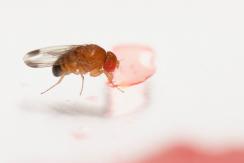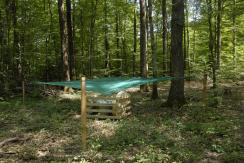Evolutionary Ecology
The department of Evolutionary Ecology gathers complementary skills in behavioural ecology, population dynamics, population biology, community ecology, and methodology (statistics and modelling). The research done in the department aims at studying how animal species evolve in a changing world by understanding the causes of the evolution of traits, adaptations and interactions. For that, we consider different levels of organization from individuals to populations and communities. Because organisms cannot be considered isolated from other biotic factors, we consider pathogens but also competing species within communities.
We study how individuals adapt to their environments that are largely impacted by anthropic pressures, and how life history traits and behaviour evolve in response to these pressures. Although we mainly focus on phenotype, we more and more consider the mechanistic link between the genotype and the phenotype. We develop the theoretical framework of our discipline through a conceptual and modeling approach. In parallel, we test hypotheses that arise from theoretical predictions through experimental, comparative and observational approaches on different biological models (insects, birds, mammals). Experimental approaches are developed in the laboratory (insect model) and in natura (bird, insect and mammal models). Observational and comparative research is mainly concerned with vertebrates. Our approaches are also, and increasingly, interested in the mechanisms of adaptive responses. In addition to the classical approaches of demographic analysis and trait change, methods of ecophysiology, chemical ecology and molecular biology are used.
Our department hosts several long-term studies of wild populations of different species. These long-term studies offer a valuable way to understand how biotic and abiotic factors affect individuals’ life history traits, and the functioning of populations in natura. Five populations of mammalian species are thus monitored for several years (more than 40 years on roe deer, 30 on Alpine marmots, 25 years on cats, 16 years on zebras, and 20 years on impala). Two of our study sites (La Sassière in Vanoise National Park (Alpine marmots) and Hwange National Park) have been certified as “Site d’Etude en Ecologie Globale” (SEEG), and two (ZA “Hwange” and ZA “Antarctic and sub-Antarctic”) were certified as “Zone Atelier” by the CNRS.
The department of Evolutionary ecology is also largely involved in training activities. Lastly, we also have strong socio-economic relationships. Indeed, because we address questions of major societal interest (global warming, public health) we tightly collaborate with socio-economic partners (Office Français de la Biodiversité, Vanoise National Park, Hwange National Park in Zimbabwe, Office National des Forêts, etc.) and participate to general public and media events.
Publications
Display of 1531 to 1560 publications on 2449 in total
Visualisation de données multivariées: réimplémentation des fonctionnalités graphiques de la librairie ade4
1ères Rencontres R .
Conference paper
see the publicationHow to measure and test phylogenetic signal
Methods in Ecology and Evolution . 3 : 743-756
Journal article
see the publicationEstimating herbaceous plant biomass in mountain grasslands: a comparative study using three different methods
Alpine Botany . 122 : 57-63
Journal article
see the publicationModelling the seasonal spread of an emerging pestivirus in a structured Pyrenean chamois population
13. Symposium of the International Society for Veterinary Epidemiology and Economics (ISVEE) . : 580 p.
Conference paper
see the publicationSeasonal spread of a pestivirus in a structured Pyrenean chamois population: a modelling tool
61. WDA - 10. biennal EWDA Conference "Convergence in Wildlife Health" . : 438 p.
Poster
see the publicationA simplified model system for Toxoplasma gondii spread within a heterogeneous environment
Nonlinear Dynamics . 68 ( 3 ) : 381-399
Journal article
see the publicationBovine tuberculosis in "Eurasian" badgers (Meles meles) in France
European Journal of Wildlife Research . 59 ( 3 ) : 331--339
Journal article
see the publicationLinking habitat characteristics with genetic diversity of the European pine marten (Martes martes) in France
European Journal of Wildlife Research . 58 : 909--922
Journal article
see the publicationTowards a vertebrate demographic data bank
Ornithol . 152 : 617-624
Journal article
see the publicationEffet Allee comportemental chez les parasitoïdes : impacts démographiques et conséquences pour la lutte biologique
2. Entomophagous Insects Conference .
Conference paper
see the publicationRole of deformed shell effects on the mass asymmetry in nuclear fission of mercury isotopes
Physical Review C . 86 ( 6 ) : 064601
Journal article
see the publicationSperm competition roles and ejaculate investment in a promiscuous mammal
Journal of Evolutionary Biology . 25 : 1216--25
Journal article
see the publicationGenital morphology linked to social status in the bank vole (Myodes glareolus)
Behavioral Ecology and Sociobiology . 66 : 97--105
Journal article
see the publicationInbreeding avoidance behaviour of male bank voles in relation to social status
Animal Behaviour . 83 : 453--457
Journal article
see the publicationPlasticité phénotypique et réponses adaptatives aux changements environnementaux chez les insectes
Geographic variations of life history traits and potential trade-offs in different populations of the parasitoid Leptopilina heterotoma
The Science of Nature Naturwissenschaften . 99 ( 11 ) : 903-912
Journal article
see the publicationSpatial heterogeneity in mortality and its impact on the population dynamics of Eurasian woodcocks
Population Ecology . 54 : 305 - 312
Journal article
see the publicationLa biodiversité à travers des exemples. Services compris.
978-2-11-129644-2 : 184
Book
see the publicationPaleodemographic analysis of a fossil porcupine (Hystrix refossa Gervais, 1852) population from the Upper Pleistocene site of Geula Cave (Mount Carmel, Israel)
Journal of Archaeological Science . 39 ( 9 ) : 3027-3038
Journal article
see the publicationMise au point d’un modèle de diagnostic des interactions entre structures paysagères, infrastructures de transports terrestres et espèces emblématiques. Le cas du Lynx dans le massif jurassien
Report
see the publicationEnvironmental factors associated with the seroprevalence of Toxoplasma gondii in wild boars (Sus scrofa)
61. Annual Meeting of the Wildlife Disease Association .
Poster
see the publicationFuelling flight in a parasitic wasp: which energetic substrate to use?
Ecological Entomology . 37 ( 6 ) : 480-489
Journal article
see the publicationEnvironmental factors associated with the seroprevalence of Toxoplasma gondii in Wild Boars (Sus scrofa), France
EcoHealth . 9 ( 3 ) : 303-9
Journal article
see the publicationImmune phenotype and body condition in roe deer: individuals with high body condition have different, not stronger immunity.
PLoS ONE . 7 ( 9 ) : e45576
Journal article
see the publicationThe Harttiini (Siluriformes, Loricariidae) from the Guianas: a multi-table approach to assess their diversity, evolution, and distribution
Cybium : Revue Internationale d’Ichtyologie . 36 ( 1 ) : 115-161
Journal article
see the publicationPaleogenetic Analyses Reveal Unsuspected Phylogenetic Affinities between Mice and the Extinct Malpaisomys insularis, an Endemic Rodent of the Canaries
PLoS ONE . 7 ( 2 ) : e31123
Journal article
see the publicationTrue versus false parasite interactions: a robust method to take risk factors into account and its application to feline viruses.
PLoS ONE . 7 ( 1 ) : e29618
Journal article
see the publicationCommunity ecology in the age of multivariate multiscale spatial analysis
Ecological monographs . 82 ( 3 ) : 257 - 275
DOI: 10.1890/11-1183.1
Journal article
see the publicationTowards a renewed research agenda in ecotoxicology
Environmental Pollution . 160 ( 1 ) : 201-206
Journal article
see the publication





You also, comment on this article